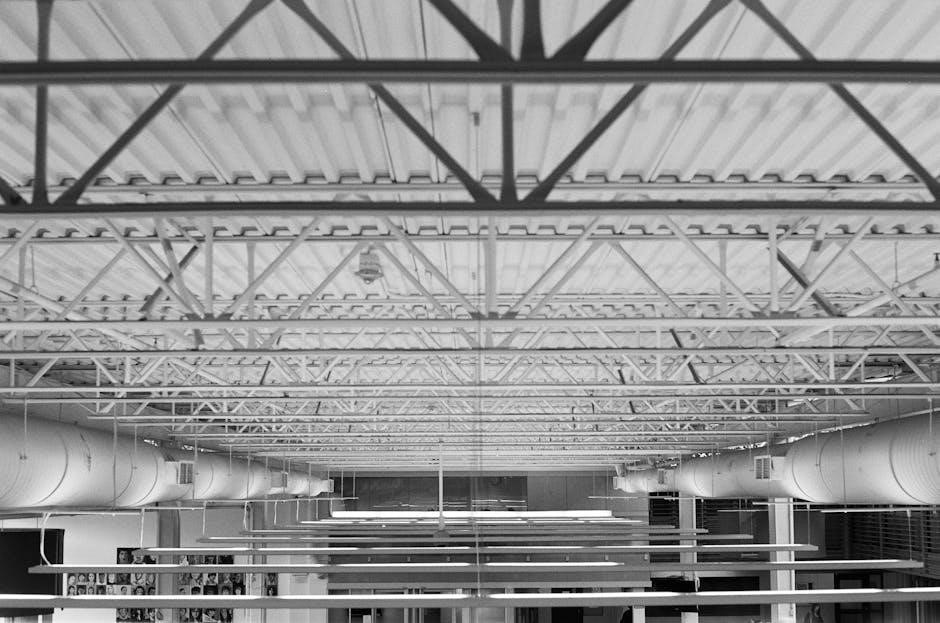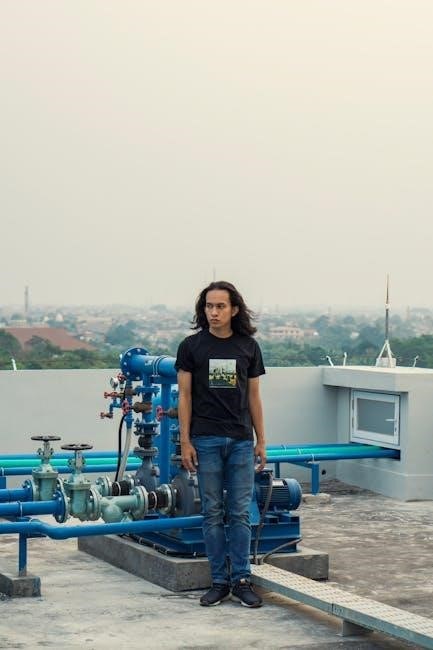Non-invasive mechanical ventilation (NIMV) is a life-saving technique delivering respiratory support via masks without invasive airway access, reducing intubation risks and enhancing patient comfort in acute and chronic respiratory failure management.
1.1 Definition and Overview of NIMV
NIMV offers non-invasive respiratory support through masks or nasal prongs, utilizing methods like CPAP and BiPAP. It’s crucial for managing acute and chronic respiratory failures, enhancing lung function, reducing intubation risks, and improving patient comfort and clinical outcomes significantly.
1.2 Historical Development and Evolution of NIMV
NIMV has evolved significantly since its inception, with early forms of non-invasive ventilation emerging in the mid-20th century. The development of CPAP in the 1980s marked a turning point, followed by advancements in BiPAP technology. Modern NIMV integrates sophisticated ventilators and interfaces, reflecting continuous innovation driven by clinical research and technological advancements to improve patient outcomes and expand its applications.
1.3 Importance of NIMV in Modern Respiratory Care
NIMV is a cornerstone in modern respiratory care, offering a less invasive alternative to traditional ventilation. Its ability to reduce intubation rates, lower infection risks, and enhance patient comfort has made it indispensable in treating both acute and chronic respiratory conditions. The versatility of NIMV ensures its widespread use across various clinical settings, improving outcomes and quality of life for numerous patients globally.
Types of Non-Invasive Mechanical Ventilation
Non-invasive mechanical ventilation includes modes like CPAP and BiPAP, each tailored to specific respiratory needs, offering adaptable and effective solutions for diverse clinical applications.
2.1 Continuous Positive Airway Pressure (CPAP)
CPAP delivers a constant pressure of air through a mask, keeping airways open during sleep. Widely used for obstructive sleep apnea, it improves oxygenation and reduces respiratory effort. Non-invasive and well-tolerated, CPAP is also applied in acute settings like cardiogenic pulmonary edema, enhancing gas exchange and patient comfort effectively.
2.2 Bilevel Positive Airway Pressure (BiPAP)
BiPAP provides two pressure levels: higher during inhalation and lower during exhalation. This mode is particularly effective for patients with chronic obstructive pulmonary disease (COPD) and acute respiratory failure, offering enhanced comfort and facilitating easier breathing. It supports spontaneous efforts, improving ventilation and gas exchange, making it a versatile option in both acute and chronic respiratory care settings.
2.3 Other Modes of Non-Invasive Ventilation
Beyond CPAP and BiPAP, other modes include average volume-assured pressure support (AVAPS) and proportional assist ventilation (PAV). AVAPS ensures consistent tidal volumes, while PAV synchronizes with patient effort, enhancing comfort. These modes are tailored for specific patient needs, offering flexibility in managing diverse respiratory conditions and improving adherence to therapy.

Benefits and Advantages of NIMV
NIMV reduces the risk of ventilator-associated pneumonia, improves patient comfort, and lowers complications compared to invasive ventilation, enhancing recovery and quality of life for patients.
3.1 Reduced Risk of Ventilator-Associated Pneumonia
NIMV significantly reduces the risk of ventilator-associated pneumonia (VAP) by avoiding the use of invasive airway devices, such as endotracheal tubes, which are common sources of infection. The closed system minimizes bacterial entry, and the non-invasive nature reduces the need for sedation, lowering the risk of complications and improving patient outcomes.
3.2 Improved Patient Comfort and Compliance
NIMV enhances patient comfort by allowing spontaneous breathing and reducing the need for sedation. The use of masks or helmets instead of invasive tubes minimizes discomfort, promoting better compliance and tolerance. Patients can communicate and move more freely, which improves their overall experience and adherence to therapy, leading to better clinical outcomes.
3.3 Lower Risk of Complications Compared to Invasive Ventilation
Non-invasive mechanical ventilation significantly reduces the risk of complications associated with invasive ventilation, such as ventilator-associated pneumonia (VAP) and lung injury from intubation. By avoiding the need for an endotracheal tube, NIMV minimizes discomfort, decreases sedation requirements, and lowers the risk of infections and long-term pulmonary damage, leading to shorter ICU stays and improved patient outcomes.
Clinical Applications of NIMV
NIMV is widely applied in managing acute respiratory failure, chronic obstructive pulmonary disease (COPD), cardiogenic pulmonary edema, and neonatal respiratory distress, enhancing patient outcomes significantly.
4.1 Acute Respiratory Failure (ARF)
Acute respiratory failure (ARF) is a life-threatening condition requiring immediate intervention. Non-invasive mechanical ventilation (NIMV) is a cornerstone treatment, effectively reducing the need for invasive ventilation. It improves oxygenation, decreases carbon dioxide levels, and enhances respiratory mechanics, particularly in patients with acute hypoxemic or hypercapnic failure. Early NIMV implementation can prevent clinical deterioration and reduce mortality, making it a critical tool in intensive care settings.
4.2 Chronic Obstructive Pulmonary Disease (COPD)
COPD patients often experience chronic respiratory insufficiency, particularly during exacerbations. Non-invasive mechanical ventilation (NIMV) is a cornerstone therapy, providing ventilatory support to reduce hypercapnia and improve oxygenation. Regular use can enhance quality of life, decrease hospital admissions, and slow disease progression, making it a vital long-term management strategy for advanced COPD.
4.3 Cardiogenic Pulmonary Edema
Non-invasive mechanical ventilation (NIMV) is highly effective in managing cardiogenic pulmonary edema, reducing the need for invasive ventilation. It alleviates respiratory distress by improving oxygenation and decreasing pulmonary congestion. NIMV enhances gas exchange, lowers carbon dioxide levels, and reduces the workload on the heart, leading to faster recovery and improved patient outcomes in acute cardiac decompensation scenarios.
4.4 Neonatal Respiratory Support
Non-invasive mechanical ventilation (NIMV) is a cornerstone in neonatal respiratory care, offering gentle and effective support for premature infants with respiratory distress. Techniques like CPAP and BiPAP improve lung expansion, reduce apnea, and decrease the need for invasive ventilation. NIMV minimizes lung injury, enhances gas exchange, and supports long-term pulmonary development, making it a critical tool in neonatal intensive care units for improving survival and outcomes.

Equipment and Technology Used in NIMV
Advanced ventilators, masks, and interfaces are essential for delivering non-invasive ventilation, ensuring precise pressure delivery and patient comfort while minimizing complications and improving respiratory outcomes effectively.
5.1 Ventilators and Interfaces
Ventilators and interfaces are critical components of NIMV, delivering precise air pressure through masks or nasal prongs. Modern ventilators offer modes like CPAP and BiPAP, ensuring tailored pressure control. Interfaces must be comfortable and leak-free to maintain effectiveness. Advanced features include pressure sensitivity and alarm systems, enhancing patient safety. Proper fitting and selection of interfaces are vital for optimal ventilation and patient comfort.
5.2 Masks, Helmets, and Other Accessories
Masks, helmets, and accessories are essential for NIMV delivery, ensuring proper fit and comfort. Masks come in nasal, oronasal, and full-face designs, while helmets offer an alternative for claustrophobic patients. Accessories like headgear, chin straps, and cushions minimize leaks and skin irritation. Proper sizing and customization are crucial to maximize comfort and adherence, enhancing the effectiveness of ventilation therapy.
5.3 Advances in NIMV Technology
Recent advancements in NIMV technology include portable ventilators, intelligent algorithms, and remote monitoring systems. These innovations improve portability, ease of use, and patient monitoring. Enhanced sensors and real-time data analysis enable personalized ventilation settings, optimizing patient outcomes. Additionally, quieter devices and ergonomic designs increase patient comfort, making NIMV more accessible and effective for both acute and chronic respiratory support.

Initiation and Titration of NIMV
Initiation involves selecting suitable patients, ensuring proper mask fit, and starting with low pressures. Titration adjusts settings based on clinical response, improving effectiveness and comfort.
6.1 Patient Selection and contraindications
Patients with acute respiratory failure, COPD exacerbations, or cardiogenic pulmonary edema are ideal candidates. Contraindications include severe respiratory failure, inability to breathe spontaneously, and conditions requiring immediate intubation, such as airway obstruction or coma. Proper selection ensures effective treatment and avoids complications.
6.2 Setting Up and Adjusting Ventilator Parameters
Initiate with non-invasive ventilation using CPAP or BiPAP modes. Start with lower pressures, gradually increasing based on patient tolerance and clinical response. Adjust inspiratory and expiratory pressures to optimize gas exchange, ensuring comfort and minimizing leaks. Continuous monitoring of respiratory mechanics and patient feedback is crucial for effective parameter titration and ensuring therapeutic efficacy.
6.3 Monitoring and Troubleshooting Common Issues
Monitor patients on NIMV for leaks, skin irritation, and respiratory mechanics. Common issues include mask discomfort and inadequate ventilation. Troubleshoot by adjusting fit, humidifying air, and ensuring proper synchronization with the patient’s breath. Regularly assess blood gases and clinical status to optimize therapy and address complications promptly, ensuring patient safety and treatment efficacy in acute and chronic respiratory settings.
Outcomes and Efficacy of NIMV
NIMV significantly reduces intubation rates, improves gas exchange, and enhances quality of life for chronic users, demonstrating its effectiveness in managing respiratory failure and promoting patient recovery.
7.1 Reduction in Intubation Rates
Non-invasive mechanical ventilation significantly reduces the need for intubation in patients with acute respiratory failure. Early intervention with NIMV avoids invasive procedures, lowering complications like ventilator-associated pneumonia. Proper patient selection and monitoring ensure its effectiveness, making it a preferred first-line treatment for conditions such as COPD exacerbations and cardiogenic pulmonary edema.
7.2 Improvement in Gas Exchange and Respiratory Mechanics
NIMV enhances gas exchange by increasing oxygenation and reducing carbon dioxide levels. Positive pressure ventilation improves lung volumes and decreases the work of breathing, benefiting patients with acute hypoxemic and hypercapnic respiratory failure. Enhanced respiratory mechanics lead to faster recovery and reduced need for invasive interventions, as evidenced by improved clinical outcomes in various studies.
7.3 Enhanced Quality of Life for Chronic Users
Chronically ill patients benefit significantly from NIMV, with improved respiratory function and reduced symptoms of breathlessness. Enhanced mobility and sleep quality contribute to better overall well-being, allowing patients to engage in daily activities and maintain independence. Long-term use of NIMV has been shown to increase patient satisfaction and life expectancy, making it a cornerstone in chronic respiratory care management.
Future Directions and Research in NIMV
Future research focuses on advancing NIMV technology, improving accessibility, and expanding clinical applications to enhance respiratory care globally, ensuring better outcomes for diverse patient populations.
8.1 Emerging Technologies and Innovations
Emerging technologies in NIMV include smart sensors, AI-driven ventilators, and portable devices, enhancing real-time monitoring and personalized therapy. Advances in mask design and materials improve comfort and seal. Innovations like 3D-printed interfaces and cloud-connected systems enable better customization and remote monitoring, promising to revolutionize respiratory care and expand accessibility for patients worldwide.
8.2 Expanding Indications for NIMV
Recent research broadens NIMV applications beyond traditional uses, now including pediatric care, neonatal support, and post-operative recovery. Its efficacy in managing various respiratory conditions, such as pneumonia and asthma exacerbations, is being explored. This expansion highlights NIMV’s versatility as a first-line treatment, reducing the need for invasive methods and improving patient outcomes across diverse clinical scenarios.
8.3 Global Access and Education
Enhancing global access to NIMV requires addressing disparities in resource-limited settings through affordable technology and training. Educational programs for healthcare providers and patients are crucial to optimize NIMV use. Collaborative efforts between manufacturers, NGOs, and governments can ensure widespread availability and proper implementation, improving respiratory care outcomes worldwide while reducing disparities in treatment access.

Educational Resources and Guidelines
Comprehensive resources, including clinical guidelines and training programs, are essential for effective NIMV implementation, ensuring healthcare providers deliver evidence-based care and improve patient outcomes effectively.
9.1 Clinical Practice Guidelines for NIMV
Clinical practice guidelines for NIMV provide evidence-based recommendations on patient selection, initiation, and titration of therapy. They emphasize monitoring and troubleshooting, ensuring safe and effective use. Developed by organizations like the European Respiratory Society and the American Thoracic Society, these guidelines aim to optimize outcomes, reducing complications and improving quality of life for patients requiring non-invasive ventilation support.
9.2 Training Programs for Healthcare Providers
Training programs for healthcare providers focus on enhancing skills in NIMV setup, patient assessment, and troubleshooting. These programs include hands-on workshops, online modules, and case-based learning, ensuring staff are proficient in using ventilators and interfaces. Continuous education is emphasized to stay updated with advancements, improving patient care and adherence to clinical guidelines in NIMV applications across various settings.
9.3 Patient Education Materials
Patient education materials provide clear, accessible information on NIMV use, benefits, and safety. These resources, often in PDF formats, include guidelines, diagrams, and troubleshooting tips, empowering patients to manage their therapy effectively. Materials also address common concerns, such as mask fitting and anxiety, ensuring better compliance and understanding of NIMV as a life-enhancing treatment option.